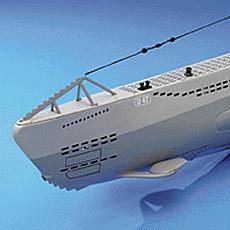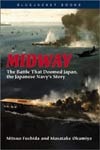The fact that Robbe is a German company makes the U-47 a "true" German U-boat - albeit a replica, but who better to replicate the original U-Boot than the Germans? The boat is a dynamic diver that measures around 67" (1.67m) in length and weighs about 20 lbs. when completed. As a dynamic diver, the boat maintains a constant state of positive buoyancy, Robbe's directions state that if trouble is encountered while operating the boat, simply turn off the motors and the boat will rise to the surface on its own accord.
The kit is very complete and of high quality. Two heavy duty Robbe electric motors needed for power are included as is a complete compliment of running gear. I would consider this boat at least "intermediate" in terms of complexity and therefore would not recommend this kit to anyone without experience in constructing comparable devices like R/C aircraft or ships.
The kit is representative of the very early Type VIIB, faithfully recreating the U-47 at the time of the Günther Prien's victory at Scapa Flow. The U-47 at that time had a small conning tower with the early style upward flared spray shield on the conning tower and virtually no Wintergarten, other than what was allowed by the streamlined contours of the conning tower itself. The lack of a suitable gun platform on the minuscule wintergarten necessitated the placement of the 2cm C/30 Flak gun on the deck just aft of the conning tower. The railings for this gun and the forward 8.8 cm "deck gun" are widely separated with no connecting railing or cables leaving the boat with a railing detail that looks a bit different then the later standard Type VII railing.
The major components of the kit, hull and superstructure, are made of ABS material formed by the vacuum forming process. A large sheet of ABS is inserted over a slightly undersized "male" die. The sheet is then heated to the point where the sheet of ABS plastic is pliable. At the proper point of pliability the sheet is drawn down over the male mold by extracting the air out from underneath so the soft pliable sheet of ABS conforms to the male mold. This process leaves a sheet with a raised impression in the middle.
 The vacuum molding process means that such
components must be glued using an external seam formed by the flat portion
of sheet that extends out from the formed impression. This makes a smooth
seam somewhat more difficult to obtain then when the parts are molded using
the more expensive injection molding process that allows for a smooth
"butt" type joint. The limber hole cut-out sections employed by Robbe are
interesting as they are molded separately from the hull of the same ABS
material as the hull. The builder cuts out a large, open, section of hull
located under the limberhole area. The precast limber hole sections are
then glued onto the recessed area over the cutaway areas on the hull. This
construction technique leaves a seam around all the limberhole areas. These
seams must then be filled in to restore the scale hull lines. The bow net
cutter is molded from ABS and is quite heavy in appearance. If the net
cutter is included on the boat it would probably be best to reconstruct it out of brass.
The vacuum molding process means that such
components must be glued using an external seam formed by the flat portion
of sheet that extends out from the formed impression. This makes a smooth
seam somewhat more difficult to obtain then when the parts are molded using
the more expensive injection molding process that allows for a smooth
"butt" type joint. The limber hole cut-out sections employed by Robbe are
interesting as they are molded separately from the hull of the same ABS
material as the hull. The builder cuts out a large, open, section of hull
located under the limberhole area. The precast limber hole sections are
then glued onto the recessed area over the cutaway areas on the hull. This
construction technique leaves a seam around all the limberhole areas. These
seams must then be filled in to restore the scale hull lines. The bow net
cutter is molded from ABS and is quite heavy in appearance. If the net
cutter is included on the boat it would probably be best to reconstruct it out of brass.
The kit is advertised as Semi-scale but I have yet to perform the measurements to find out just where the differences lie, although overall the boat appears quite scale in appearance. The guns are injection molded and nicely done as are the periscope heads, which are turned from aluminium. The running gear includes all dive planes, depth control apparatus, double rudders, linkages, propellers, propeller tubes and shafts, through hull bellows, tubing and the like. The water tight inner hull is constructed of what appears to be heavy duty PVC or ABS tubing of a yellow/beige colour. The watertight inner hull is equipped with water tight caps with "O" rings on both ends of the inner hull. The end caps have some molded in access holes with nipples to allow tube and bellows clamping other holes must be drilled however.
The outer hull is built around the circular inner watertight hull, making the inner hull an integral component of the boat much like the construction employed on the actual boat. The boat breaks vertically at the stern section in the last third of the hull. The entire stern section can then be removed to access the inner hull's equipment deck The inner equipment deck slides in and out with the stern section to accommodate access to the electronic components such as batteries, motors and radio equipment, which are all located on the equipment deck.
The instructions appear to be quite complete and multilingual in format. Included are three large full scale drawings, a 74 page book detailing construction and operating steps in German, English and French. Of course the completeness and accuracy of instructions can never be fully ascertained until the construction is complete but knowing the Germans penchant for mechanical accuracy IF YOU FOLLOW ZE INSTRUCTIONS, YOU VILL HAFF A RUNNING BOOT!
The boat can apparently be constructed first and then the radio and electronics can be added after completion of the submarine. Other than the usual non-inclusive items like glue and paint the only other required items to complete the kit are a 4 channel radio, speed control, MCD mini, and batteries. The cost of these items will almost double the initial purchase price of the boat.
Having never built an R/C submarine on this scale, I would say that this is an excellent beginners submarine kit for builders with other R/C and/or ship experience as it dispenses with the complexity of a water ballast system yet gives the beginning builder a good introduction to the complexities of constructing an R/C submarine. The completeness of the kit allows the builder to work on the kit while eliminating the need to search continuously for various major and minor components, a problem that I have seen on other less complete "kits". Such parts hunting often contributes to the discouragement of the builder on any project.
When addressing projects such as this I have found that after the fundamentals of construction and operation of the device is fully understood, less complete and more complex examples can be attempted with confidence. The boat and a description can be seen at http://www.robbe.com
Written by Gary Ley
We might have pictures of this model in the future.
Some notes on this model
The price of Robbe's model of U 47 is 650 DM.
The model is quite detailed but a lot of details are to be made by the model builder himself.
The model is made of ABS plastics.
Two Motors are also included... A nice model.



